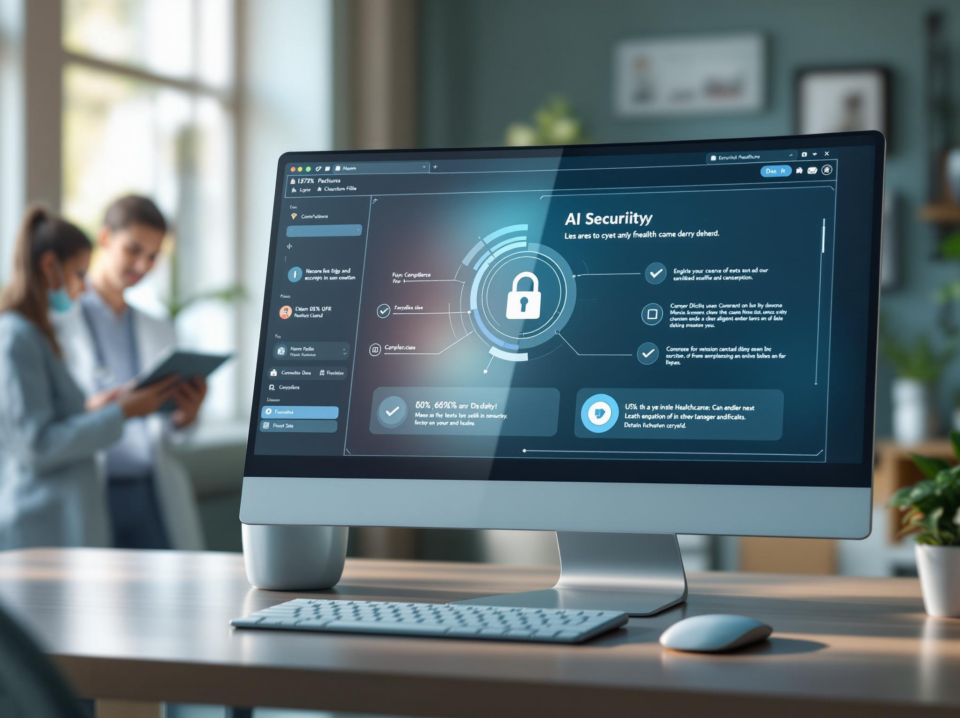Doctors are burning out, and administrative tasks are a big reason why. AI medical transcription tools are stepping in to help by automating documentation, saving time, and improving accuracy. Here’s how they’re making a difference:
- Save Time: Doctors reclaim hours daily by automating note-taking and EHR updates.
- Boost Accuracy: AI reduces documentation errors to nearly zero.
- Improve Work-Life Balance: Less after-hours work means more personal time.
- Enhance Patient Care: More time for patients leads to better diagnoses and treatment.
- Streamline Workflows: Seamless EHR integration simplifies daily tasks.
- Ensure Data Security: GDPR & HIPAA compliant tools safeguard sensitive patient information.
These tools are already making an impact where healthcare organizations see a 20% drop in errors and a 15% efficiency boost within ten weeks of adopting AI transcription in 2023. Want to know more? Keep reading to explore all seven benefits in detail.
How Ambient Clinical Intelligence and AI Tools Reduce Physician Burnout
1. Cutting Down on Administrative Tasks
Administrative tasks often take up a significant portion of healthcare providers’ time, leaving less room for patient care. AI medical transcription is changing the game by automating these time-intensive processes.
The result? Doctors save over two hours each day and can attend to 4,000 more patients annually. Viviotex‘s platform, VivioMed, captures patient-physician interactions and automatically updates EHRs with structured notes, eliminating the need for manual data entry.
Here’s a breakdown of how AI medical transcription helps reduce administrative burdens:
| Feature | Benefit | Impact |
| Real-time Capturing | Automates note-taking and documentation in real time. | Frees doctors to focus on patient care. |
| Telehealth Support | Enables capturing audio during digital consultations (e.g., Zoom meetings). | Ensures accurate documentation for remote consultations. |
| EHR Integration | Transfers notes directly to electronic health records. | Reduces manual data entry and administrative workload. |
| Multi-language Support | Allows selection of a preferred language for consultations. | Improves accessibility for diverse patient populations. |
| Results Translation | Generates results in the preferred language, regardless of the language used during the consultation. | Enhances usability and ensures clear communication across languages. |
The key to success lies in selecting AI tools that integrate smoothly with current EHR systems while offering an easy-to-use interface. This ensures that healthcare providers can adopt the technology without additional complications.
2. Increasing Documentation Accuracy
Precise clinical documentation is essential for effective patient care, and AI medical transcription offers a major improvement over traditional methods by significantly reducing errors. Manual transcription usually has an error rate of 3.7%, but AI-driven tools are changing the game with advanced speech recognition and natural language processing.
Take TPMG’s use of AI transcription as an example – it has boosted both accuracy and efficiency across healthcare settings. This technology captures complex medical terms and various speech patterns with precision, turning spoken communication into well-organized and reliable records.
Key features of AI transcription that enhance accuracy include:
| Feature | Impact on Accuracy | Benefit to Physicians |
|---|---|---|
| Medical Term Recognition | Captures specialized terms correctly | Saves time correcting terminology errors |
| Real-time Processing | Enables immediate content verification | Allows instant corrections |
| Structured Documentation | Automates formatting and organization | Ensures consistent, standardized records |
| EHR Integration | Directly transfers verified data | Eliminates manual entry mistakes |
This level of precision helps reduce physician burnout by removing the stress of fixing documentation errors and minimizing the time spent on reviews. With fewer administrative burdens, healthcare professionals can dedicate more focus to critical clinical decisions.
3. Saving Time for Doctors
Managing time effectively is crucial for reducing physician burnout, and AI medical transcription tools are making a big difference in this area. These AI-powered tools save doctors many hours by automating documentation tasks.
VivioMed, by Viviotex, a platform that uses AI for documentation, showcases how these tools streamline essential tasks and cut down delays:
| Time-Saving Feature | Benefit for Physicians |
|---|---|
| Real-time, Automated Note-Taking | Removes the need for manual documentation during or after appointments |
| Direct EHR Integration | Eliminates repetitive data entry |
| Pre-designed Templates | Speeds up routine documentation with templates tailored to individual needs |
| Multi-template support | Enables access to different templates tailored for different specialities or new/re-visits. |
With 77% of healthcare professionals working overtime to complete notes, AI transcription tools help ease this workload by automating the process. These tools learn and adapt to individual speech patterns, further reducing the need for edits. Over time, they become even more efficient at organizing and formatting documentation as they are used more frequently.
4. Supporting Better Work-Life Balance
AI transcription tools are reshaping how physicians handle their workloads, giving them back personal time and helping to ease burnout. By automating clinical documentation, these tools allow doctors to finish their tasks during regular hours rather than bringing work home.
For example, The Permanente Medical Group saw noticeable improvements in work-life balance among its 10,000 physicians just ten weeks after introducing AI transcription tools in 2023. These tools have changed daily workflows, helping doctors better separate their professional responsibilities from personal time.
Here’s how AI medical transcription aids in achieving a healthier work-life balance:
| Benefit | Impact on Work-Life Balance |
|---|---|
| Reduced After-Hours Work | Frees up hours daily and eliminates weekend charting |
| Lower Cognitive Load | Eases stress tied to administrative tasks |
| Predictable Schedules | Creates more time for family and personal activities |
To make the most of these tools, healthcare organizations should integrate them thoughtfully into clinical workflows. This ensures that the time saved through automation improves work-life balance rather than adding more patient responsibilities. The goal is to use these tools effectively to maintain high-quality care while establishing clear boundaries for the workday.
Revolutionize Healthcare Documentation
Streamline your clinical workflows with AI-powered medical notes automation. Save time, enhance accuracy and data structure.
e time, enhance accuracy and data structure.
5. Improving Patient Care and Satisfaction
AI-powered medical transcription allows doctors to spend more time with their patients, improving the quality of care and reducing the stress of managing documentation alongside patient interactions.
OpenAI’s Whisper model highlights these advantages by enabling real-time documentation. This capability allows physicians to treat an additional 4,000 patients daily while still maintaining high standards of care.
Here’s how AI transcription is making a measurable difference in patient care:
| Patient Care Aspect | Improvement |
|---|---|
| Enhanced Patient Interaction | Doctors gain an extra 60 minutes daily and can focus better during consultations. |
| Documentation Accuracy | Medical record errors reduced by 3.7%. |
| Patient Volume | Increased capacity without lowering care quality. |
The Permanente Medical Group’s adoption of ambient AI technology showcases these benefits. After rolling out AI transcription tools to 10,000 physicians in October 2023, they reported noticeable improvements in documentation accuracy and patient care within just ten weeks.
“The implementation of AI medical transcription tools has fundamentally changed how our physicians approach patient care”, says Ahmed Luay of Viviotex.
With AI handling documentation, physicians can concentrate fully on their patients. This not only enhances communication but also helps doctors pick up on subtle patient cues they might otherwise miss. The result? More accurate diagnoses, better treatment plans, and improved health outcomes.
6. Simplifying Clinical Workflows
AI-driven medical transcription is transforming how clinical workflows operate by integrating directly with Electronic Health Record (EHR) systems. This eliminates repetitive data entry and simplifies documentation, helping to ease the burden on physicians.
CloudIQ, utilizing OpenAI’s Whisper model and ChatGPT API, takes physician-dictated notes and converts them into structured documentation that syncs directly with EHRs. This automation removes the need for manual data transfers and reduces the mental load involved in managing documentation tasks.
| Workflow Improvement | How It Helps Reduce Burnout |
|---|---|
| Automated EHR Integration | Cuts out manual data entry |
| Real-time Documentation | Lessens after-hours workload |
| Structured Note Generation | Simplifies organizing and inputting data |
| Cross-System Compatibility | Reduces the need to switch between platforms |
The benefits of smoother workflows are clear in large-scale implementations. For example, The Permanente Medical Group introduced ambient AI technology to their 10,000-physician network in October 2023. Within just ten weeks, they saw noticeable gains in workflow efficiency.
Another example is Viviotex’s VivioMed platform, which captures patient-physician conversations in real time and automatically generates structured medical notes compatible with various EHR systems. Facilities using AI transcription report reduced operational costs and improved resource allocation.
While simplifying workflows is a game-changer, it’s equally important to ensure these systems maintain top-notch data security.
7. Ensuring Data Privacy and Security
While improving workflows is important, protecting patient data is just as crucial for alleviating physician stress. AI transcription platforms come equipped with advanced security features designed to safeguard sensitive medical information. This allows doctors to focus on patient care rather than worrying about compliance issues.
Platforms like VivioMed provide top-tier security across their documentation workflows. They even offer deployment options like on-premises solutions for healthcare organizations that need full control over their data.
| Security Feature | How It Reduces Stress |
|---|---|
| HIPAA-Compliant Infrastructure | Removes the burden of manual compliance checks |
| Automated De-identification | Cuts down time spent reviewing sensitive data |
| Role-based Access Controls | Simplifies managing user permissions |
| Secure EHR Integration | Ensures safe and smooth data transfer processes |
Healthcare organizations using AI transcription tools often notice reduced stress levels among physicians. These tools automate compliance tasks and protect patient data, letting doctors concentrate fully on patient care without the added pressure of administrative tasks.
“The consequences of not prioritizing data security in medical transcription can include data breaches, fines, and reputational damage. It can also compromise patient trust and confidentiality, which are essential in healthcare”.
Platforms like CloudIQ show how AI transcription tools can combine strong security with easy usability. They integrate seamlessly with EHR systems while maintaining strict data protection protocols. Features like encryption, automated compliance checks, and incident response systems ensure doctors can prioritize patient care without worrying about security.
Conclusion
AI medical transcription is making a real difference in healthcare by tackling one of the primary causes of physician burnout: overwhelming administrative tasks. With 77% of healthcare professionals working late due to documentation demands, these tools are helping to ease the burden and improve overall well-being.
For example, The Permanente Medical Group has shown how AI transcription tools can consistently cut down documentation time and errors in large-scale settings [3]. Platforms like VivioMed highlight how these systems can fit smoothly into existing EHR workflows, offering real-time transcription and customizable templates that reshape how physicians manage their daily tasks.
Here’s what AI transcription tools are achieving:
- Saving physicians about an hour every day
- Reducing documentation errors from 3.7% to almost nothing
- Cutting down after-hours work [3]
These benefits are backed by both studies and practical applications, proving their value in lightening the workload for healthcare professionals.
Healthcare organizations looking to adopt AI medical transcription should prioritize solutions with:
- Easy integration with EHR systems
- Strong HIPAA-compliant security measures
- Robust training and ongoing support
“Inefficient documentation impacts both physician well-being and patient care quality. AI transcription tools offer a proven solution to these challenges” [3].
As healthcare evolves with advanced technologies, AI transcription is emerging as a key resource for improving both physician satisfaction and patient care. By embracing these tools, organizations can better support their teams and deliver higher-quality care – a win for everyone involved.
FAQs
How will AI impact medical transcription?
AI is changing the game in medical transcription by automating documentation tasks and boosting efficiency. These changes are reshaping how doctors handle clinical documentation, offering clear advantages in several areas.
Here’s how it affects healthcare providers:
- Simplified Documentation: AI tools take over routine tasks, giving doctors more time to focus on patients and reclaim personal time – helping to address burnout directly.
- Improved Accuracy: AI transcription reduces errors, cutting down on mistakes that can weigh on healthcare providers.
- Faster Processing: AI platforms quickly turn physician dictations into organized records, streamlining workflows.
“Inefficient documentation impacts both physician well-being and patient care quality. AI transcription tools offer a proven solution to these challenges” [3].
This matters because 77% of physicians currently work overtime to finish notes [3]. AI transcription helps by automating the process, increasing accuracy, integrating with EHRs, and ensuring HIPAA compliance.
For healthcare organizations looking to adopt these tools, it’s essential to choose solutions with strong EHR integration and thorough training support.







